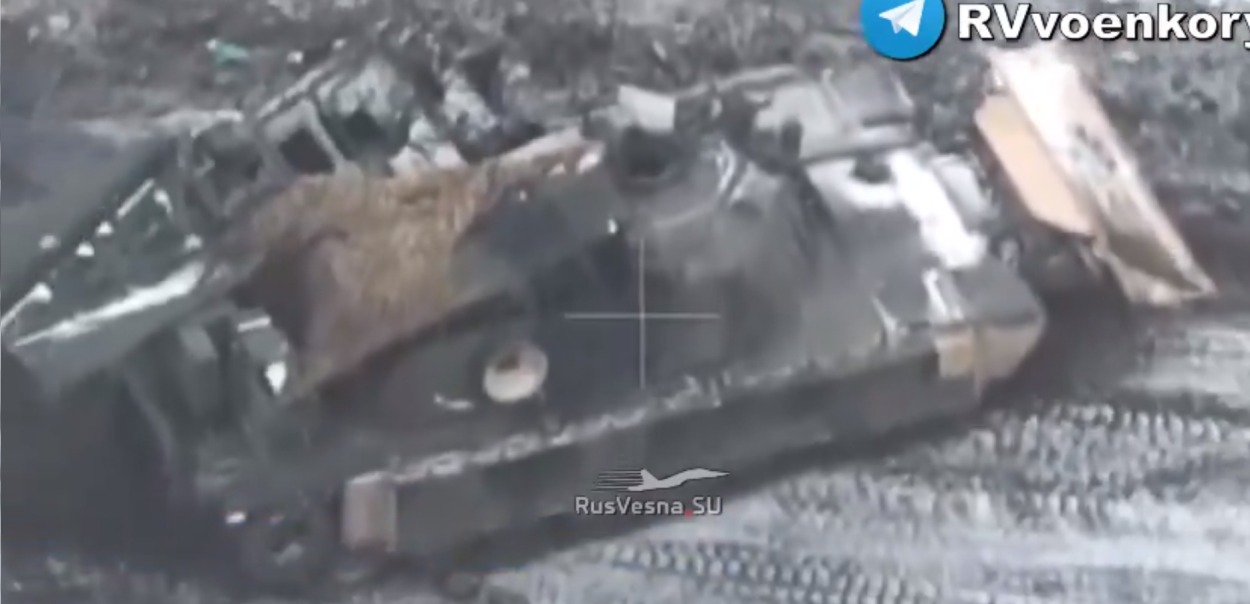Russia has significantly scaled the production of First Person View (FPV) drones that knocked out the first Ukrainian M1A1 Abrams Main Battle Tank (MBT) from the battlefield in February 2024.
The Simbirsk Design Bureau Piranha, which manufactures FPV drones in Russia, recently stated that it has produced over 35,000 unmanned aerial vehicles (UAVs) since 2022, Russian state news agency TASS reported. “The production capacity is 1,000 unmanned aircraft systems a day,” the design bureau has disclosed.
The Russian Defense Ministry announced on February 27, 2024, that Russian forces had destroyed an Abrams tank manufactured in the United States in the vicinity of Avdiivka in the Donetsk People’s Republic (DPR) on February 26.
The destruction of the tank came as a breakthrough for the Russian forces at the time, which aggressively pushed inside Avdiivka and managed to capture the town.
Later, a representative from Piranha confirmed that an FPV manufactured by the company had obliterated the American-origin tank.
“I received this information from a customer who sent a communication with the commander of the battalion team that had hit the tank. He said that it was our Piranha. Then this information appeared in news stories and Telegram channels showing the footage of the burning Abrams,” the representative said at the time.
The representative also emphasized that the primary purpose of the FPV drones produced by the company is to target Ukrainian army positions and dugouts.
He went on to claim that “Piranha” is unique in the frequencies that it operates in, which offers it a tactical advantage. “No one has video transmitters on such a frequency. During electronic warfare tests, it proved to be the only drone that could not be suppressed,” he told the media.
First US-supplied M1A1 Abrams MBT in Ukrainian service seen damaged/destroyed. Blowout panels can be seen deployed pic.twitter.com/ej72loRhMo
— OSINTtechnical (@Osinttechnical) February 26, 2024
According to the latest TASS report, it was Piranha-10 that destroyed the Abrams MBT.
The TASS report states that they could carry up to 5 kilograms of cargo, depending on the type. The Piranha-7 and Piranha-10 drones can accelerate up to 140 kilometres/hour and are intended to deliver direct hits or remote-controlled explosions to enemy personnel, equipment, and other locations.
Abrams destroyer: What we know about the Piranya drone
The Piranya (Piranha) unmanned aerial vehicle was recently used by Russia to destroy Ukraine’s US-made M1 Abrams tank. It was developed by the Simbirsk Design Bureau located in the Russian city of Ulyanovsk.
Some things… pic.twitter.com/WBNfAa8ZEP
— Sputnik (@SputnikInt) February 28, 2024
Meanwhile, the 8-motor Piranha-13 UAV can carry up to 11.5 kilograms of payload and deal a heavy blow to many high-value targets. It can transport small cargo and medications in addition to ammo, and has the highest lifting capacity in the Piranha drone family.
Notably, Piranha FPV drones are designed for kamikaze-style strikes, particularly against armored vehicles.
Though little is known about this class of FPV drones apart from the basic details, we know that First Person View (FPV) drones, in general, are small, agile, and inexpensive drones that were originally designed for civilian racing. However, as the war dragged on, they were repurposed as precision weapons, reconnaissance tools, and even psychological weapons, which ended up reshaping fundamental modern warfare.
Equipped with thermal cameras and armed with small payloads, FPVs deployed by Ukraine and Russian forces defeated the purpose of trenches and exposed infantry to fire, while also hunting down armoured vehicles behind enemy lines.
While it was Ukraine that first started unleashing FPVs on Russia, the latter has now scaled up FPV use, particularly with fiber-optic drones, which are unjammable by electronic warfare (EW) systems.
The destruction of the Abrams tank was certainly one of the biggest kills scored by the Piranha FPV family. The Russian forces have since destroyed or severely damaged several Abrams tanks as well as Leopard-2 MBTs using their FPVs, significantly impacting Kyiv’s ground operations and dealing a blow to the reputation of these cutting-edge tanks.
Russia’s War On Ukrainian Abrams
The United States delivered 31 M1A1 Abrams MBTs to Ukraine in September 2023, in an attempt to bolster the embattled country’s ground-based capability against Russia, and after months of lobbying and campaigning by Ukrainian officials. The tanks were deployed by the Ukrainian Army to the frontline in February 2024.
Shortly after they first emerged on the battlefield, the Abrams suffered a debacle, with Russia launching a war against them using its cheap and expendable FPV drones. This led to their eventual withdrawal from the battlefield.
As of now, 22 tanks have been lost, either destroyed or damaged, or abandoned, according to Oryx, a Dutch open-source intelligence website that tracks military losses on both sides. The actual losses could be even higher, given that Oryx only relies on visual confirmation for documenting the losses.
Ukrainian media stated that, like the majority of main battle tanks in service with Ukraine, the Abrams are designed to engage in “tank-on-tank” combat and are equipped with substantial frontal protection. However, the Russians struck them where they were most vulnerable: from above. The Abrams proved to be extremely vulnerable to FPV attack drones. Moreover, these tanks were not equipped with the latest upgraded depleted uranium armor and fire control systems, which made them even less useful.

Nearly all of these attack drones unleashed by Moscow on Kyiv’s US-origin tanks are controlled via virtual reality screens strapped over the operator’s eyes and forehead for improved control, as the feed is displayed from the drone’s perspective.
These drones are generally retrofitted with warheads or explosives from Rocket-Propelled Grenade (RPG) rounds, capable of penetrating the thinner top, side, or rear armor of tanks. According to some reports, the FPV drones deployed by Russia used PG-7VL warheads with 500mm penetration, sufficient to breach the Abrams’ weaker top armor. Earlier, a video published by a Russian Telegram channel showed an FPV drone striking an Abrams near Avdiivka, causing a fire and likely ammunition detonation.
The FPVs are guided in real-time via low-latency video feeds, allowing operators to target weak points like optics, engine compartments, or open hatches.
Russian forces typically deploy their FPV drones, including the Piranha, in swarms. They frequently work in tandem with reconnaissance drones to overwhelm Ukrainian defenses. They target tanks in open fields, urban environments, or during retreats, exploiting mobility limitations.
In close-quarters combat, FPVs are known to exploit confined spaces to approach undetected, perhaps flying through windows or gaps to hit tanks. This tactic was reportedly used against Ukrainian tanks in Bakhmut.
After initial losses, the Ukrainians started equipping their tanks with cope cages. However, Russian FPVs demonstrated they could use a double strike to penetrate these protective layers.
The first drone penetrated the cope cage or netting, and the second followed immediately after targeting the damage caused by the first, and getting through to the armor of the tank. This means that the Abrams or the Leopard-2 have had little room to maneuver in the ongoing combat.
The threat of FPV drones has reduced Ukraine’s tank deployments, pushing reliance on artillery and infantry. While Ukraine is now getting additional tanks, such as the Australian Abrams, the increase in production of FPVs like Piranha in Russia may spell doom for them once again. In fact, it may be aimed at deterring their deployment in the first place
- Contact the author at sakshi.tiwari9555 (at) gmail.com
- Follow EurAsian Times on Google News




